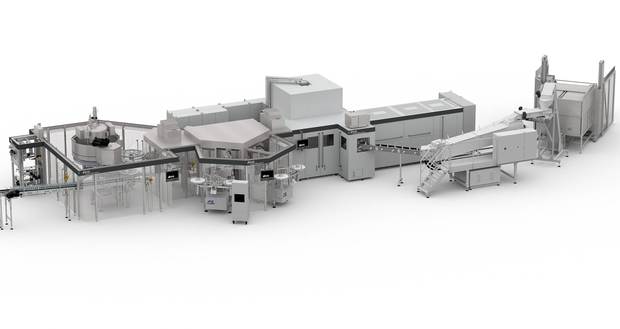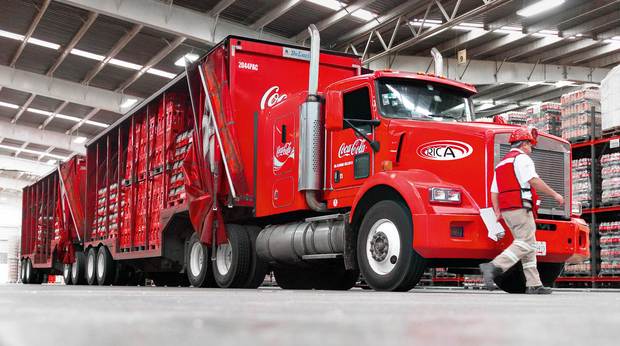When the second-largest mineral water bottling plant in Germany boosts its capacities, only the most advanced technology is good enough – as was the case at the Hanse-Heemann production site in Bruchsal in Baden. Its three existing lines gained two additional high-performance filling lines, permitting the supply of beverages to customers in southwest Germany to be increased. “Our aim was to secure the future of our bottling plant as a leading, powerful production site for soft drinks,” explains plant manager Thomas Herzog. Accordingly, the demands were challenging. “The balance between efficiency on the one hand and production reliability on the other plays an important role here. We need systems which enable low operating costs, low energy consumption and effective personnel deployment as well as the maximum in line and output capacity.” These criteria are not merely clichés, as project manager Michael Weller is keen to point out, but obligatory requirements. Hansa-Heemann makes the majority of its turnover as a supplier to discounters and a contract filler for other brand name producers. All of these clients chiefly assert their position on the market by constantly seizing every opportunity to cut costs with their suppliers. “For us beverage producers this means that we constantly have to find new ways of optimizing the packaging of our products, for instance.”
Enormous challenges
Here, KHS offers strong support to the mineral water bottler. Michael Weller has worked with KHS in the past and had good experience with the company. He thus has great trust in the Dortmund systems supplier and it’s this which ultimately earned KHS the contract. Trust is essential in a project of this magnitude which was to be implemented in Bruchsal. The actual technical challenges to be mastered are naturally of a totally different nature. “Lightweighting is taking us to the limit of what is actually still feasible. The systems are designed for capacity, however, and this has to be reconciled with the above. At the same time our processing windows are getting smaller and smaller. This means that every single unit on a line faces challenges which are often extreme. KHS has successfully mastered these challenges.”
Efficient performance control
Twelve machines apiece were built into both PET lines in a two-block design, from the fully automatic two-component KHS Innopro Paramix blending system with a capacity of up to 72,000 liters per hour through the InnoPET BloFill blow molder/filler block and Innoket labeler to the packaging and palletizing machines. The biggest pluses according to project manager Weller are the machine layout, which is based on a clear operating concept, and the new technology of the blocked blow molder and filler. His greatest enthusiasm is reserved for another innovation, however. “The conveyor control unit regulates the line performance extremely efficiently. Stop-and-go operation is avoided, resulting in an improved overall level of line efficiency.”
Performance Control 4.0
Unlike conventional control units, where the situation on the individual conveyors is determined by sensors, the Performance Control 4.0 counting controller records the exact number of all containers in circulation. Based on their number and diameter the occupied space in the various segments can be better estimated and the calculation of the machine speed is much more precise.
If there are delays on the labeling machine, for example, the preform infeed can be stopped later and the buffer capacity better exploited. Besides the product flow consumables are also tracked.
The next reel change can be scheduled, for example, by assessing the number of processed containers, amount of labels or film used and the corresponding residual quantities. The available buffer can be reduced by the amount necessary to compensate for the reel change and continue production. This principle is applied to the entire line, resulting in gentler, more continuous system operation.
In brief
The benefits of the counting controller for PET lines from KHS
→ Less stop-and-go operation
→ Higher level of line efficiency
→ Shorter, fewer downtimes
→ Less wear
Up to the limit
During the extension of the plant’s capacities every phase in production from blending to warehousing was included in the planning and implementation of the project – and all this during the ongoing season. The great complexity of the mammoth project was further complicated by the extremely tight schedule, Herzog remembers. “We could only withstand the immense time pressure we were all under through sheer stamina and joy in our work – and by looking forward to successful line acceptance at the end of the project as our reward.”
The travails of the conversion are now long forgotten. Compared to the three existing lines the new systems consume about 20% less energy thanks to their innovative machine technology. This alone has enabled Hansa-Heeman’s initial objective to be reached of noticeably cutting the total cost of ownership (TCO). The facilities in Bruchsal now have such modern, productive lines that the plant is running in the high capacity range.
This wouldn’t have been possible without the easy cooperation of both companies. “It was hugely important to us that we had reliable contacts at KHS who were personally committed to the success of the project and were available round the clock,” concludes Herzog. The commitment of all involved and the fact that they identified with the project were decisive, he continues. “At some point you could no longer tell who was the supplier and who was the customer – and that’s just how it should be.”
“The balance between efficiency and production reliability plays an important role.”
Your contact on this topic
Thomas Hüser
Technical support
KHS GmbH, Bad Kreuznach, Germany
Phone: +49 671 852 2716
Email: thomas.hueser@khs.com


























